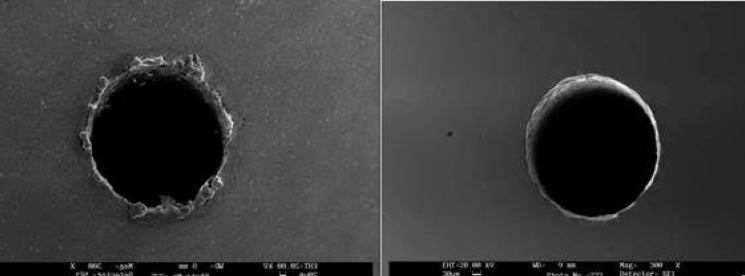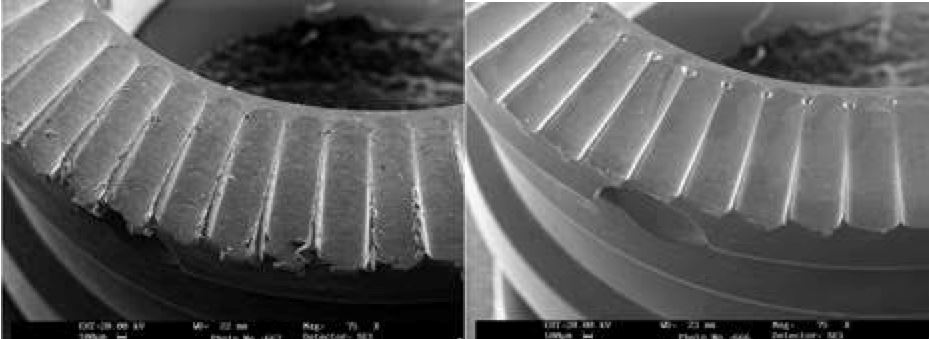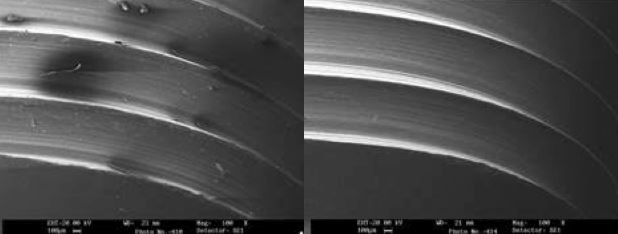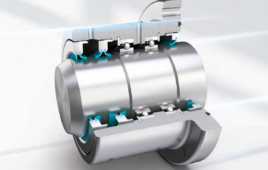Precision is critical to the effective long-term performance of most metal parts, and part of that precision is ensuring a part’s Roughness Average (Ra) value falls within an acceptable range. From primary manufacturing processes to secondary operations, including finishing processes, many stages in the manufacturing of metal parts can introduce foreign metals or other contaminants to the part, or negatively impact qualities such as smoothness, corrosion resistance, and electrical conductivity.

303 Stainless steel part with EDM-formed holes – before and after electrofinishing (300X magnification). Image coutrtesy of Able Electrofinishes
Depending on the eventual application and use of your metal parts, different finishing processes, both macro and micro, can be used to ensure the parts perform adequately and have an optimal cycle life. When determining which microfinishing process will perform best for your metal parts, there are three things you should keep in mind:
1. How Microfinishing Impacts Product Performance
Microfinishing is, by definition, is designed to eliminate very small variations in a part’s metal surface. However, while the irregularities that microfinishing seeks to correct may be small, their impact on the part’s eventual performance and cycle life can be large. For parts that will be used in electronic applications, conductivity is of critical importance. Having a specific Ra value can optimize part performance and help prevent electrical arcing, which can cause serious damage to expensive electrical equipment, preventing it from functioning as intended. Irregularities in the metal surface of a part can interrupt the flow of electricity, causing costly malfunctions and false readings. Adequate microfinishing is of particular importance for electronics used in medical applications, such as MRI machines, where high voltages are present and a damaged machine can cost the hospital valuable revenue.

8620 Steel insert before and after electropolishing
The impact of inadequate microfinishing is also pronounced in pneumatic and hydraulic applications, where multiple metal parts are moving in close contact with one another. Having the proper degree of friction is crucial for these machines, and a high Ra average can produce unwanted levels of friction. This friction can then impede the part’s performance and, over time, cause damage that weakens the part and ultimately, shortens the lifespan.
2. Microfinishing Options
Before you can choose the microfinishing option most beneficial for your metal parts, it is helpful to gain a basic understanding of the differences between the microfinishing options available to you. Some of the most common methods of microfinishing metal parts include:
· Mechanical Polishing. Mechanical polishing uses abrasive materials on wheels and belts to remove thin layers of metal parts. This process is effective in achieving low Ra values, but relies heavily on the operator and cannot easily be used to deliver precise, consistent results. Mechanical polishing in most cases can also only be performed on one part at a time, making it more expensive than other alternatives. In addition, it is not well-suited for more intricate, complex parts with areas that are hard to access.
· Vibratory Finishing. This type of finishing is performed in a bulk fashion in vibratory bowls that contain various types of media and lubricants. The process relies on part to media friction to smooth a part’s surface. This process is not suited for fragile parts that can easily become distorted and can be very time consuming.
· Electropolishing. Electropolishing is very cost effective and flexible process that can be used for one part or millions of parts. As electropolishing removes a consistent, thin layer of metal from the surface of the part, the microfinish improvement is consistent across all parts in a batch. In addition to improved microfinish, electropolishing greatly enhances corrosion resistance and the removes microburrs. Furthermore, electropolishing can also eliminate oxide scale and heat tint from prior procedures and provide the parts with a clean, bright finish.

SEM photos of threads before and after electropolishing (100X magnification)
3. Do You Know Your Products’ Ra Value?
A metal part’s Ra (roughness average) is the average of a set of individual measurements of a surfaces peaks and valleys. The surface is measured with a profilometer and typically called out in microinches or micrometers. A greater Ra value indicates a greater variance and higher degree of roughness in the surface, and metal parts with a Ra value higher than what is acceptable for their specific application may malfunction, wear, and have a shortened lifespan. Knowing the degree of smoothness necessary for a given metal part should play a role in determining which microfinishing process is best. You should also be aware of the metal part’s Ra value prior to microfinishing and what can realistically be achieved. With .001” (.0005” per surface) material removal, electropolishing can reduce a part’s Ra value by up to 50%.
#################################
Tom Glass is President at Able Electropolishing www.ableelectropolishing.com/, the world’s largest electropolishing specialist offering electropolishing, passivation, titanium anodizing, and laser marking services. Able Electropolishing is an ISO 9001 and 13485 certified company serving a variety of industries including aerospace, medical device mfg., food & beverage, automotive and more.
Filed Under: Industrial automation




